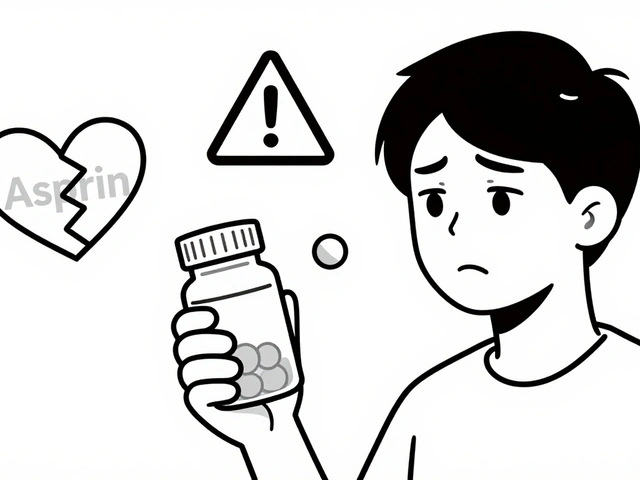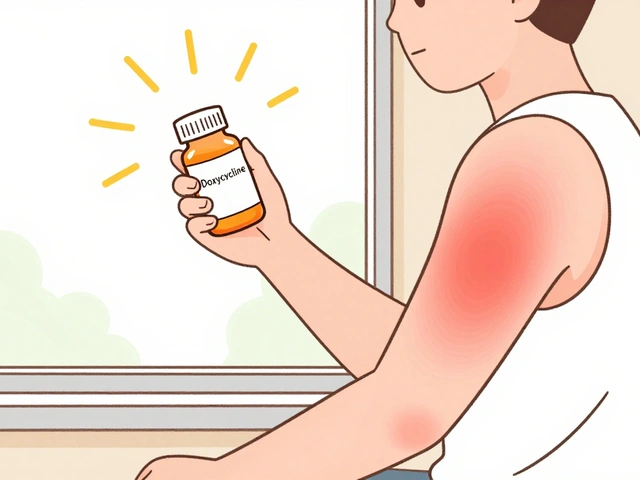
If you’ve ever had a run-in with threadworms (pinworms), you know how wildly annoying and even embarrassing it can be. The itching, the restless nights, the sheer frustration of knowing there are tiny creatures freeloading inside your body (or, even worse, your kid’s body)—it’s enough to keep anyone up. So, when you hear the name Vermox, your first thought is usually relief. But there’s a lot more to this little orange tablet than just being a quick fix.
What is Vermox and Why is it Used?
Vermox isn’t some new player—this medicine has been used for decades across the world (especially in places like Australia, New Zealand, the UK, and the US). Its magic comes from the active ingredient called mebendazole. It’s especially famous for tackling those household nemeses: pinworm and threadworm, but it works on roundworms, whipworms, and hookworms too. Worm infections are shockingly common, even in developed countries. In New Zealand, school outbreaks of threadworm are so routine, most parents either have a Vermox box tucked away with the plasters or wish they did.
Here’s how it works: Vermox blocks the worms’ ability to absorb glucose. Without their energy source, the worms can’t survive. No energy means the worms die off (usually in a day or two) and your body sends them packing via the usual route… yep, right down the loo. Nothing dramatic, but definitely effective. Most people start feeling way better within a couple of days, especially that tell-tale nighttime itch, which is the signature symptom of pinworm infections.
Who can use Vermox? It’s approved for adults and children over two years old, so it’s on the gentler side among medications. You don’t need a prescription in New Zealand—it’s over-the-counter, so you can grab it from the local chemist. But it’s not open season for everyone: those with allergies to mebendazole should steer clear, and it’s always wise for pregnant women and breastfeeding mothers to chat with their GP before taking it—it’s not officially recommended in early pregnancy just to be safe.
One thing folks often ask is, “Can I use Vermox if I’m not sure it’s worms?” The honest answer is—it’s better to be sure. Kids scratching their bums at night is a classic sign, but sometimes a quick look (yes, a torch and a nighttime peek at the bottom) is the simplest way to spot the culprit: little white wriggly things about a centimetre long. Vermox works when it’s needed, but overusing it isn't wise since it doesn’t prevent future infections, it just kills current ones. A proper diagnosis makes sense for your wallet and your body.
Let’s talk numbers. According to the New Zealand Formulary, a single 100 mg tablet is the standard dose for pinworm. For whipworm or roundworm, the routine is usually one tablet (100 mg) twice a day for three days. In most cases, a single dose does the trick, but with pinworm, it’s smart to repeat the dose after 2–4 weeks because the eggs can survive outside the body. So, if your child’s still itching two weeks later—don’t panic, just repeat.
One reminder: Vermox only works on the worms in your system. It won’t kill eggs lurking on soft toys, bed linen, or under fingernails. That’s why paired-up hygiene goes hand in hand (pun intended) with treatment.

How to Use Vermox Safely for Best Results
Taking Vermox isn’t complicated, but a few tricks can make it more effective. First, you don’t need a fancy meal—take it with or without food. For kids, the tablet can be chewed (the taste isn’t too brutal), or crushed up and mixed into food if needed. Avoid giving the medicine to kids under two years old unless a doctor says otherwise. And sorry, dogs and cats aren’t candidates for Vermox—it’s for humans only.
Your next battle is stopping the never-ending cycle of reinfection. Those worm eggs are sneaky: they get stuck under fingernails, scatter all over bedding, and find their way onto hands, toys, and food. Each adult worm can lay thousands of eggs in a single night, so you see how the problem snowballs. This is why one sick child often equals the whole household scratching in their sleep. That’s also why it’s recommended to treat everyone under the same roof—even if they don’t have symptoms—especially with pinworm.
Getting the hygiene right counts for as much as the medicine. Here’s a kitchen-table action plan:
- Wash hands before every meal and after using the loo—teach the kids the song, make it fun, but don’t skip it.
- Trim fingernails short—no secret hideaways for eggs.
- Change sheets, pajamas, and underwear daily for a few days after the first dose.
- Hot wash all bedding and towels. Cold won’t cut it—heat destroys the eggs.
- Clean the bathroom, especially around the toilet, each day for a week.
- Discourage fingernail biting or thumb-sucking—it’s a prime way to give worms a second home.
A bit of effort here saves a load of drama later. If you follow these steps, the chances of re-infection drop massively. But remember: some unlucky souls can get repeat infections (especially in schools and daycares—it’s the dark side of group play!). Antihistamines won’t help with the itching—that’s just the worms’ calling card, and only deworming meds like Vermox will kick them out.
Now, side effects. Most people breeze through Vermox treatment without any drama. Occasionally, people get a mild stomach ache, some gas, or might feel a bit queasy. Kids sometimes get a mild rash. Allergic reactions, like hives or swelling, are super rare, but if it happens, get help straight away. There’s no known interaction with the birth control pill, so no worries there. Unlike some meds, no need to change diet or avoid certain foods—the worms themselves are the thing to avoid!
Studies from KidsHealth NZ and Medsafe show that for pinworm treatment, Vermox has a cure rate of about 90–95% after a single dose if hygiene is sorted too. The medication is so staple here that it’s on the Ministry of Health’s recommended list for treating most common worm infections.
| Worm Type | Treatment in NZ | Standard Vermox Dose | Cure Rate (%) |
|---|---|---|---|
| Pinworm (Threadworm) | Yes | 100mg x 1, repeat in 2–4 wks | 90–95 |
| Roundworm | Yes | 100mg x 2 daily for 3 days | 85–95 |
| Whipworm | Yes | 100mg x 2 daily for 3 days | 80–90 |
| Hookworm | Yes | 100mg x 2 daily for 3 days | 80–90 |
Don’t rush to retake the meds if one dose doesn’t instantly clear all symptoms—worms take a day or two to die off fully and the itching sometimes lingers, even after they’re gone. Only repeat treatment after 2–4 weeks if symptoms return. If things get worse or you see blood in stools, or your child loses weight or appetite, it’s time to see a doctor for further checks.

Common Questions & Handy Tips About Vermox
Let’s clear up some of the myths and quirks people often have about Vermox:
- Should you treat everyone at home? Ideally, yes, especially with pinworms. Treating just one person while everyone else shares sheets, toilets, or snacks means you’ll be playing worm ping-pong—frustrating and expensive.
- Is Vermox safe for pregnancy? It’s a grey area. Animal studies haven’t shown big risks, but there’s not enough human data to totally clear its use, especially in the first trimester. If you’re pregnant, talk it through with your midwife or doctor first. If you breastfeed, short-term use is usually fine since hardly any passes into breastmilk.
- Is one dose enough? For most worm types, yes. For pinworm, you should repeat the dose in 2–4 weeks to catch newly hatched worms. For other worms, stick to the three-day regime.
- My child vomited after the first dose. What now? If they throw up within an hour, you can repeat the dose. If it’s been longer, it’s probably absorbed already.
- Can I use Vermox preventively? It’s tempting, but not best practice. Only take it if you or someone in your house is definitely infected. Prevention relies much more on hygiene.
- Where do worms come from? Most eggs spread via hands, toys, bedding. Pinworm eggs can survive two weeks on surfaces. Kids, with their hands everywhere, are often the main spreaders. Schools and preschools see lots of cases, especially in Auckland’s big family-friendly neighborhoods. It’s not from dirty homes—just clever worms taking advantage.
- Do pets pass on human worms? No, cats and dogs have their own worm types. Humans don’t catch pinworm from pets, and vice versa.
- Can adults get infected? Adults can and do, especially if they live with kids. It’s common and nothing to be ashamed of. Hygiene helps, but you can still get unlucky sometimes.
- What if the infection keeps returning? You might be missing hidden eggs around your house, or forgetting to treat everyone. Deep-clean all shared spaces, remind kids about handwashing after every loo trip, and consider talking to your family doctor to rule out less common causes and get extra advice.
Some folks swear by natural remedies—garlic or pumpkin seeds get tossed around the internet. While there’s no harm in eating healthily, there’s zero scientific proof these home tricks get rid of worms. Stick with what’s proven, like Vermox, and you’ll have a much better shot at a worm-free home.
If you’ve never experienced the lovely joy of pinworms, you’re in the lucky minority. Most parents in Auckland have faced this at least once. Vermox doesn’t just help you sleep better at night. It lets your kids get back to school, keeps the rest of the family itch-free, and most of all, stops awkward conversations at the dinner table about ‘wiggly things’. So, if you find yourself in that itchy, sleepless boat, remember you’re not alone—and at least there’s an easy way out of the wormhole.




7 Comments
So basically Vermox is the OG worm destroyer? 🤯 I had pinworms as a kid and my mom just handed me this orange pill like it was a gummy bear. No drama, no tears, just… poof. Worms gone. I still don’t know how I got them, but I’m 32 now and I still side-eye any kid scratching their butt at the playground. 😅
It is frankly astonishing that this article casually endorses a non-prescription anthelmintic without a single citation to peer-reviewed clinical trials. Mebendazole’s efficacy, while historically documented, has been increasingly questioned in light of emerging resistance patterns in Southeast Asia and the lack of randomized controlled trials in modern pediatric populations. The assertion that ‘90–95% cure rate’ is universally applicable is misleading without stratification by geographic region, sanitation infrastructure, or genetic polymorphisms in worm populations. This is not medical advice-it’s a marketing pamphlet disguised as public health guidance.
While I appreciate the thoroughness of the piece, I must point out that the hygiene recommendations, though technically accurate, are utterly unrealistic for families with multiple children, working parents, and limited access to laundry facilities. ‘Hot wash all bedding daily for a week’? That’s not a suggestion-it’s a luxury. And suggesting parents ‘use a torch to inspect their child’s bottom at night’ borders on absurd. If we’re going to treat this as a public health issue, we need systemic solutions-not individualized guilt trips wrapped in bullet points.
Thank you for the comprehensive and meticulously structured overview. The inclusion of dosage protocols by worm type, coupled with clear contraindications and hygiene protocols, reflects a commendable alignment with evidence-based clinical practice guidelines. The distinction between treatment and prophylaxis is particularly well-articulated, and the emphasis on household-wide intervention is critical in interrupting transmission cycles. This represents a model of patient-centered educational content that balances accessibility with scientific rigor.
Let’s be real-worms are the ultimate party crashers. They don’t care if you’re rich, clean, or a PhD in microbiology. They just show up, set up camp in your colon, and start throwing midnight raves in your rectum. Vermox? That’s the bouncer who kicks them out with zero tolerance. And yeah, sure, the hygiene stuff is annoying-but if you don’t wash your sheets after treatment, you’re basically inviting the worms back for a sequel. And no, pumpkin seeds won’t save you. I’ve tried. I’ve eaten them like they’re the new kale. The worms just laughed. Vermox? That’s the only MVP here.
i read this whole thing and im like… why is this so long?? i just wanted to know if it works. yes. does it hurt? no. do i need to wash everything? kinda. do i need to treat my whole fam? yessss. why does the internet make everything a novel?? anyway, my kid got it last year, we did the pill, washed the pjs, and boom. no more 3am butt-scratching. also, cats dont give it to you. good to know. 😴
Why are we giving kids over-the-counter worm meds like candy? In my day, you didn’t get medicine unless a doctor said so. Now it’s just ‘grab the orange pill’ like you’re buying gum. This is why America’s falling apart-no discipline, no boundaries, no respect for medical authority. And don’t even get me started on treating the whole household. That’s not medicine, that’s socialism for parasites. If your kid has worms, maybe stop letting them lick the toilet seat and wash their hands like a civilized human being. But hey, if you wanna hand out Vermox like Halloween candy, go ahead. I’ll be over here, raising my kids with hygiene and self-control.